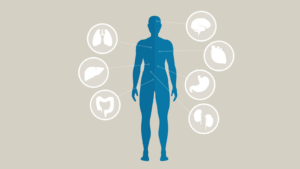
Life holds a number of mysteries that have yet to be solved.
From the vast and ever-expanding universe to the unexplored depths of our oceans, there is still much to be learned about our existence. However, what is really perplexing to researchers is a little closer to home.
The endocannabinoid system (ECS) is a recent discovery in the scientific community, which is surprising given its necessity and vitality to our day-to-day function. Without this intricate and powerful biological machinery, we would not survive.
Stoners may have heard of the ECS as it’s the system in which cannabis interacts with to give it its long list of effects. But stoner or not, there is something that everyone can learn from the ECS.
What is the ECS?
The ECS is a biological system composed of three main components that work together to regulate many of our body’s functions. It can best be described as a system responsible for maintaining the homeostasis of our bodies. For instance, our ECS regulates sleep, mood, hunger, pain, inflammation, hormones, memory, and more.
When something is operating outside of the right range, our bodies activate the ECS to help correct it. So when your stomach starts to growl, you can thank your ECS for reminding you to eat. The same goes for when you are cold and start to get goosebumps – that’s your ECS at work!
History of the ECS
So what came first, the plant or the person? Turns out, the plant – and by a long shot. Cannabis is believed to have evolved 28 million years ago on the Tibetan Plateau. To put that in perspective, the oldest homo sapien fossils recovered date back only 300,000 years, and our earliest known ape-like ancestor still doesn’t scratch the surface, having evolved six million years ago.
Despite these huge historical gaps, humans quickly discovered cannabis, and it’s been an integral part of our evolution since.
Cannabis as a medicine has been documented since 8000 BC. In fact, its health benefits have been documented across nearly all cultures, from the Ancient Chinese to the Greeks and Romans, and in the earliest Indian texts.
It wasn’t until the 1960s, however, that science could prove the anecdotal claims for cannabis.
Organic chemist Raphael Echoulam first discovered the structure of THC in 1964 and shortly after began experimenting the compound on monkeys and human volunteers. After ingesting cannabis, he found that his subjects experienced various psychological reactions, from laughing to euphoria to panic attacks.
These findings eventually led to the exploration of the novel receptor system, the endocannabinoid system.
We now understand that the ECS is a vast network of chemical signals and receptors packed throughout the brain and body. These receptors control and regulate a number of things, including hunger, temperature, alertness, mood, and motor functioning.
Similarly, when Mechoulam’s lab finally isolated the first receptor in the ECS in 1992, we found that they are incredibly similar in structure to the cannabinoids present in marijuana. In other words, millions of tiny cannabis-like molecules are floating in our brains and bodies. So, when we ingest cannabis, it works its effects by hijacking this ancient biological machinery.
The ECS Deconstructed
The ECS can be broken down into three main components: lipid messengers called endocannabinoids, cannabinoid receptors that these messengers bind to, and lastly, enzymes that metabolize them when they are no longer needed.
Endocannabinoids: Also called endogenous cannabinoids, these lipid messengers are what help keep our internal functions running smoothly. Our bodies produce them as needed, so it’s difficult to know what typical levels are for each person. Experts have identified two key endocannabinoids so far.
Receptors: Endocannabinoids bind to receptors to send signals in the ECS. There are two main receptors in the body, but experts theorize a third, undiscovered one may exist. CB1 receptors are found primarily in the central nervous system, while CB2 receptors are predominantly in the peripheral nervous system, especially immune cells. When endocannabinoids bind to these receptors, it produces various effects.
Enzymes: Once the endocannabinoids have done their job, such as bringing the body back to homeostasis, enzymes come along to break them down. This prevents them from going too far and upsetting the balance in the opposite direction.
Disruptions to the ECS
Because the ECS acts as a universal regulator, when it’s out of balance, the effects can be detrimental. Researchers are currently learning about endocannabinoid deficiency and its impacts on the body. Some scientists theorize that imbalances of the ECS can explain issues like migraine headaches, fibromyalgia, and irritable bowel syndrome.
The ECS and Cannabis
So if cannabis acts on our ECS, how can we use this knowledge to better our health?
Anecdotally, cannabis is said to have a long list of benefits from mood improvement to appetite stimulation, pain management, and even anti-cancer properties. As our understanding of the ECS broadens, we’re able to uncover the mysteries of why cannabis is said to have all of these effects.
Scientifically, the research is promising on most of these claims, though it needs to be studied more to make any conclusive statements.
One preliminary finding that points in an incredibly positive direction is the potential to treat cancer. We’ve heard stories of people who’ve claimed to cure their cancer and other health ailments through cannabis. Most notable is Rick Simpson, the originator of RSO. Now science is showing us that cannabinoids do have an influence on cancer cells because of the way they interact with our receptors in the ECS.
More research is needed to answer whether cannabis can be used to treat cancer. However, as we continue to learn about the endocannabinoid system, we can hope for a future where people have a natural alternative to fight cancer.
Interested in learning more? Check out our extensive archive of educational cannabis content. We’d also love for you to follow us on Instagram to stay up-to-date on the latest Green news, events, and products.